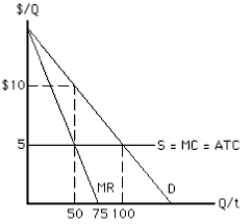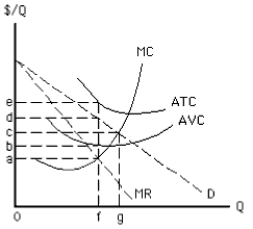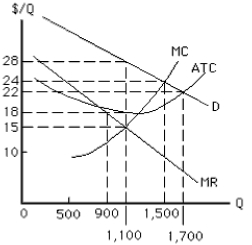A) The entry of new firms is not a major concern.
B) Monopolists seek to maximize profits.
C) Monopolists can charge any price they want and make a profit.
D) Monopolists can choose any point on the market demand curve.
E) Monopolists can raise price more than 10 percent.
Correct Answer

verified
Correct Answer
verified
Multiple Choice
Which of the following would probably not be considered a natural monopoly?
A) a municipal water company
B) the local telephone industry
C) the cable television industry
D) natural gas and electric companies
E) the automobile industry
Correct Answer

verified
Correct Answer
verified
Multiple Choice
In the short run, a monopolist will always shut down when
A) total cost is greater than total revenue at all output levels
B) total variable cost is greater than fixed cost
C) total revenue is greater than total variable cost at all output levels
D) fixed cost is greater than total revenue at all output levels
E) total variable cost is greater than total revenue at all output levels
Correct Answer

verified
Correct Answer
verified
Multiple Choice
Willie Stand obtains a patent on his new invention, the bipod. After twenty years,
A) he can renew his patent
B) new entrants will begin bipod production if price exceeds average variable cost
C) new entrants will drive up the price of the bipod
D) Willie will eventually earn no more than a normal profit
E) Willie will continue to earn a positive economic profit, because entry will not affect the price of bipods
Correct Answer

verified
Correct Answer
verified
Multiple Choice
The demand curve facing a monopolist
A) is kinked at the market price
B) is perfectly elastic
C) lies above its marginal revenue curve
D) lies below its marginal revenue curve
E) is the same as its marginal revenue curve
Correct Answer

verified
Correct Answer
verified
Multiple Choice
NARRBEGIN: Exhibit 9-16
Exhibit 9-16
 -Exhibit 9-16 depicts the cost and demand conditions facing a profit-maximizing monopolist that does not price discriminate. Which of the following statements is true?
-Exhibit 9-16 depicts the cost and demand conditions facing a profit-maximizing monopolist that does not price discriminate. Which of the following statements is true?
A) An output of 50 is allocatively efficient, but the monopolist will produce 100 units.
B) An output of 50 is allocatively efficient, but the monopolist will produce 75 units.
C) An output of 75 is allocatively efficient, but the monopolist will produce 100 units.
D) An output of 100 is allocatively efficient, but the monopolist will produce 50 units.
E) An output of 100 is allocatively efficient, but the monopolist will produce 75 units.
Correct Answer

verified
Correct Answer
verified
Multiple Choice
Which of the following is true of marginal revenue for a monopolist that charges a single price?
A) P = MR because there are no close substitutes for the monopolist's product.
B) P > MR because the monopolist must decrease price on all units sold in order to sell an additional unit.
C) P < MR because the monopolist must decrease price on all units sold in order to sell an additional unit.
D) AR = MR because there are no close substitutes for the monopolist's product.
E) P = MR only at the profit-maximizing quantity.
Correct Answer

verified
Correct Answer
verified
Multiple Choice
NARRBEGIN: Exhibit 9-12
Exhibit 9-12
 -The profit-maximizing level of output and price for the nondiscriminating monopolist in Exhibit 9-12 are
-The profit-maximizing level of output and price for the nondiscriminating monopolist in Exhibit 9-12 are
A) f and $a
B) g and $c
C) f and $b
D) f and $d
E) f and $e
Correct Answer

verified
Correct Answer
verified
Multiple Choice
A profit-maximizing monopolist
A) never produces on the inelastic portion of the demand curve because it can increase profit by increasing output
B) never produces on the inelastic portion of the demand curve because marginal revenue exceeds marginal cost
C) always produces on the inelastic portion of the demand curve
D) never produces on the elastic portion of the demand curve because there are no substitutes for the good it produces
E) never produces on the inelastic portion of the demand curve because marginal revenue is negative there
Correct Answer

verified
Correct Answer
verified
Multiple Choice
For a nondiscriminating monopolist, which of the following is false?
A) The monopolist produces where MR = MC.
B) The monopolist's marginal revenue curve is the same as its demand curve.
C) The monopolist will never produce in the inelastic range of its demand curve.
D) A monopolist is more allocatively inefficient than a perfectly competitive firm.
E) The monopolist produces where P > MC.
Correct Answer

verified
Correct Answer
verified
Multiple Choice
In the long run, which of the following is not a problem for a monopolist earning economic profit?
A) other firms have an incentive to create substitutes for the monopolist's product
B) technological change tends to break down barriers to entry
C) patents expire, licenses must be renewed, and new sources of essential resources may be discovered
D) government often decides to regulate monopolies
E) all profit will gradually be converted to consumer surplus
Correct Answer

verified
Correct Answer
verified
Multiple Choice
For a monopolist that does not price discriminate, economic profit is maximized in the short run at a price of $140. Marginal revenue at that output level is
A) equal to $140
B) greater than $140
C) less than $140
D) less than marginal cost
E) greater than average revenue
Correct Answer

verified
Correct Answer
verified
Multiple Choice
Suppose Arf n' Barf restaurant has a monopoly on restaurant food in a certain small town. Their rent, which is one of several fixed costs they pay whether they sell food or not, has gone up. In the short run, the Arf n' Barf should
A) pay the higher rent and increase menu prices
B) pay the higher rent and leave menu prices unchanged
C) pay the higher rent and lower prices
D) go out of business
E) shut down
Correct Answer

verified
Correct Answer
verified
Multiple Choice
NARRBEGIN: Exhibit 9-5-1
Exhibit 9-5
 -The nondiscriminating monopolist in Exhibit 9-5 will produce where
-The nondiscriminating monopolist in Exhibit 9-5 will produce where
A) MR = 0
B) MR = MC
C) MC < MR
D) MC = ATC
E) D = MC
Correct Answer

verified
Correct Answer
verified
Multiple Choice
For a nondiscriminating monopolist, describe the relationship between market price (P) , average revenue (AR) , and marginal revenue (MR) .
A) P = AR = MR
B) P > AR = MR
C) P = AR > MR
D) P > AR > MR
E) P = AR < MR
Correct Answer

verified
Correct Answer
verified
True/False
Average revenue equals the change in total revenue divided by the change in the quantity of output produced.
Correct Answer

verified
Correct Answer
verified
Multiple Choice
The actual deadweight loss from monopoly in the U.S. may be greater than calculated estimates because some
A) monopolies experience strong economies of scale
B) monopolists spend resources to secure and maintain their monopoly
C) monopolists may purposely keep price lower than its profit-maximizing level, in order to increase barriers to entry
D) monopolists' markets are contestable
E) monopolists' prices and profits are regulated by the government
Correct Answer

verified
Correct Answer
verified
Multiple Choice
NARRBEGIN: Exhibit 9-5-1
Exhibit 9-5
 -The firm in Exhibit 9-5
-The firm in Exhibit 9-5
A) is operating in the short run
B) is operating in the long run
C) will exit the industry in the long run
D) shut down in the short run
E) could be operating in either the short run or the long run
Correct Answer

verified
Correct Answer
verified
Multiple Choice
The supply curve for a monopolist
A) is its marginal cost curve
B) is vertical because there are no close substitutes for its product
C) is horizontal because there are no close substitutes for its product
D) slopes upward
E) does not exist
Correct Answer

verified
Correct Answer
verified
True/False
A monopolist maximizes profit at the quantity where the slope of its total revenue curve equals the slope of its total cost curve.
Correct Answer

verified
Correct Answer
verified
Showing 161 - 180 of 249
Related Exams